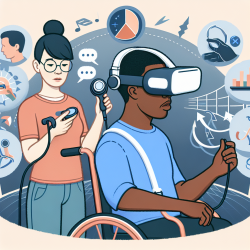In the ever-evolving landscape of special education, integrating technology into therapy can significantly enhance outcomes for students. The recent research article, A Mobile-based Virtual Reality Speech Rehabilitation App for Patients With Aphasia After Stroke: Development and Pilot Usability Study, offers a promising framework for speech rehabilitation using virtual reality (VR). This blog aims to guide practitioners on how to implement these findings to improve their skills and encourage further research in this field.
Understanding the Study
The study focuses on developing a VR-based app designed for speech rehabilitation in patients with aphasia following a stroke. Aphasia, a language impairment affecting speech, reading, writing, and comprehension, impacts about one-third of stroke patients. Traditional methods often fall short in providing immersive and engaging environments for rehabilitation. This VR app offers an innovative solution by creating interactive, real-life scenarios where patients can practice their language skills.
Key Findings and Modules
The app comprises four main modules, each addressing different aspects of speech rehabilitation:
- Oral Expression Therapy: Tasks include reading and repeating phrases, sentences, and answering questions related to everyday life.
- Auditory Comprehension Therapy: Exercises focus on listening and matching tasks, yes-no questions, and comprehension of passages.
- Cognition Therapy: Activities include attention training, memory exercises, and problem-solving tasks.
- Comprehensive Application: Real-life scenario tasks such as shopping in a supermarket, job interviews, and daily conversations in a park or restaurant.
Implementation Tips for Practitioners
Here are some practical steps to integrate this VR-based approach into your therapy sessions:
- Assess Suitability: Evaluate if the VR app is suitable for your students based on their specific needs and the app's capabilities.
- Start Gradually: Introduce the app in short, manageable sessions to gauge the student's comfort and engagement levels.
- Customize Content: Utilize the app's customizable features to tailor the therapy sessions to individual student needs.
- Monitor Progress: Keep track of the student's progress and adjust the therapy plan accordingly. The app provides detailed reports that can be useful for this purpose.
- Encourage Practice: Motivate students to use the app at home, ensuring they get ample practice in a comfortable setting.
Encouraging Further Research
The promising results from the pilot usability study suggest that further research could enhance the app's effectiveness and usability. Practitioners are encouraged to participate in ongoing studies or initiate their own research projects to explore new ways of integrating VR into speech therapy.
Conclusion
The integration of VR technology into speech rehabilitation for aphasia patients marks a significant advancement in the field. By implementing the findings from this study, practitioners can offer more engaging and effective therapy sessions, ultimately improving outcomes for their students.
To read the original research paper, please follow this link: A Mobile-based Virtual Reality Speech Rehabilitation App for Patients With Aphasia After Stroke: Development and Pilot Usability Study.










